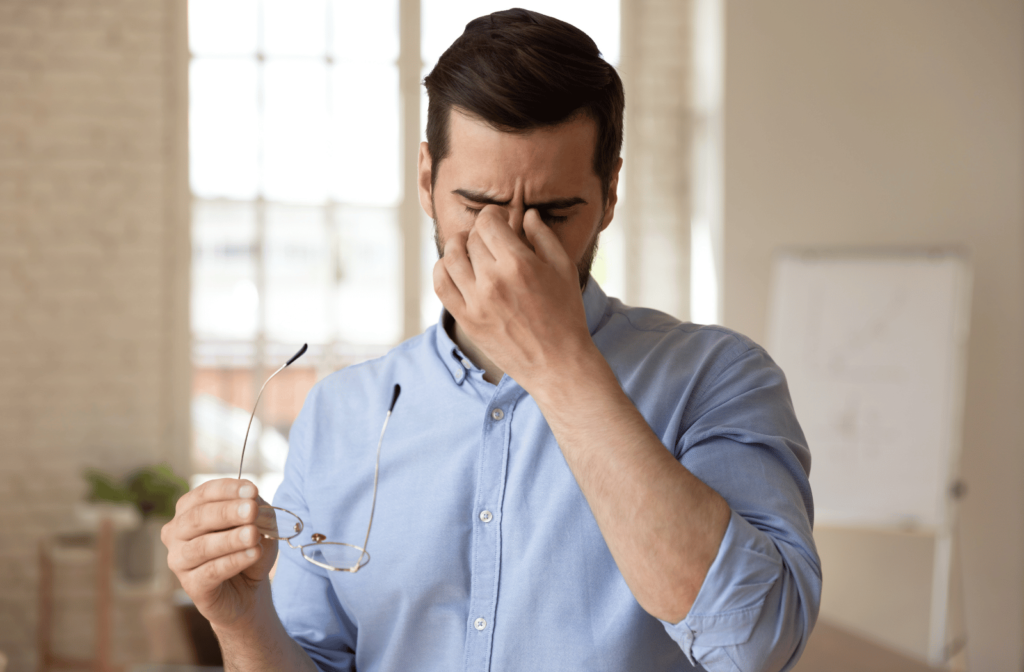Have your eyes ever felt gritty, scratchy, and just plain uncomfortable? You might have experienced dry eyes, like millions of other Canadians do each year. It can cause a range of symptoms, and when it gets severe, dry eyes can also cause blurriness.
If you’re wondering whether dry eyes are the cause of your blurry vision, a comprehensive eye exam is the best way to pinpoint the source. While blurry vision can result from dry eyes, they aren’t the only condition that can cause blurriness. Your optometrist can inspect all parts of your eyes and help you get the care you need.
What Is Dry Eye?
Dry eye disease is exactly what it sounds like; your eyes are too dry. This dryness occurs when your eyes aren’t producing enough tears or are producing poor-quality tears.
Every time you blink, you’re spreading three thin layers of oil and water across your eye called the tear film. These layers are:
- The outer oily layer keeps the tear film smooth and prevents other layers from evaporating.
- The middle watery layer keeps the eye hydrated and protects the cornea from bacteria.
- The inner mucus layer keeps the tear film attached to the eye.
Together these layers protect and nourish your eyes. However, a condition such as dry eyes can disrupt this process and leave your eyes susceptible to complications and damage.
Dry Eye Disease Symptoms
Some of the common symptoms of dry eye include:
- Stinging, burning, or scratchy eyes
- Blurry vision
- Feeling like something is in your eye
- Red eyes
- Light sensitivity
You also may experience an overproduction of tears. Usually, this is your body’s response to any irritants or uncomfortable dryness in your eyes. Still, if your tears evaporate too fast, this won’t do anything but leave you with watery eyes.
Dry Eye & Blurriness
The relationship between dry eye and blurriness can be a bit complicated since some eye conditions can cause both. As well, having both dry eye and blurry vision can be an indicator of other health conditions, such as lupus or Sjögren’s syndrome.
Contact Lenses
Wearing contact lenses can be a factor in developing both dry eye and blurry vision. In this case, a refractive error is causing your blurry vision, likely one diagnosed by your optometrist in a previous eye exam. Your contact lenses typically correct your vision, but depending on the lens type, they can also draw moisture away from your eyes and leave them dry.
Dry eyes can make it more difficult to wear your contacts and cause them to sit on your eye improperly, leaving you with the same blurry vision you once corrected.
Damage to Your Cornea
While dry eye is undeniably uncomfortable, it can be harmful if left untreated. Excessive dry eye leaves your eyes vulnerable to the elements and can damage your cornea, the clear dome at the front of your eye.
Your cornea is essential in focusing light on the layer of light-sensitive cells at the back of your eye called the retina. Together with the lens, they give you a clear vision of the world around you.
However, without a healthy tear film, your cornea is left unprotected. It’s unable to wash away irritants such as dust and dirt from your eye’s surface. Not only can this debris damage your eye, but it can also build up over time and cause your eyes to water, scattering light rays before they can enter the eye. This results in a blurry image at all distances.
Treatments for Dry Eye
If your blurriness results from dry eye, an excellent first step is to keep your eyes moisturized and nourished. Some treatments for dry eye include:
- Artificial tears: Sometimes your eyes need a hand, and specially-made eye drops called artificial tears can be the boost they need. These can be offered over the counter and are designed to soothe dry eye symptoms. Each brand has a designated number of drops a day. If you’re regularly going over this amount, contact your optometrist.
- Warming masks: If blocked glands are causing your dry eye, heated masks might be able to break down these blockages and correct your tear film.
- Punctal plugs: In some cases, a doctor can insert small plugs into your tear ducts to prevent your tears from draining too fast.
- Omega-3: Omega-3 fatty acids have been shown to lower the risk of dry eyes. You can increase your intake by adding more foods, such as fish, to your diet or taking nutritional supplements.
There are also some at-home changes or treatments you can make that might mitigate your dry eye symptoms, including:
- Ensuring you’re blinking regularly while using a computer
- Using a humidifier
- Staying hydrated
- Avoiding air getting blown in your eyes
- Wearing sunglasses outside
If you still have blurry vision after addressing your dry eye, make sure you let your optometrist know so they can investigate another cause with an eye exam.
Finding Comfort for Your Dry Eyes
Your eye should feel comfortable throughout the day, and that dry, gritty feeling is a sign that something is wrong. View Pointe Vision + Style is passionate about helping people maintain nourished and healthy eyes.
If you’re experiencing dry eyes and need immediate relief, book an appointment in Winnipeg for dry eye therapy.


